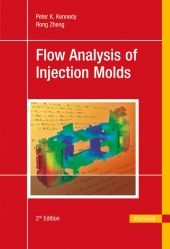 Neuerscheinungen 2013Stand: 2020-01-07 |
Schnellsuche
ISBN/Stichwort/Autor
|
Herderstraße 10
10625 Berlin
Tel.: 030 315 714 16
Fax 030 315 714 14
info@buchspektrum.de |

Peter Kennedy, Rong Zengh
(Beteiligte)
Flow Analysis of Injection Molds
2nd ed. 2013. XXVIII, 349 p. w. figs. 248 mm
Verlag/Jahr: HANSER FACHBUCHVERLAG 2013
ISBN: 1-56990-181-3 (1569901813) / 1-56990-512-6 (1569905126) / 3-446-18050-8 (3446180508)
Neue ISBN: 978-1-56990-181-6 (9781569901816) / 978-1-56990-512-8 (9781569905128) / 978-3-446-18050-5 (9783446180505)
Preis und Lieferzeit: Bitte klicken
For mechanical engineers, polymer engineers, and applied mathematicians who want to increase their understanding of flow analysis technology, this book is a thorough introduction to the theoretical background of computer simulation of the injection molding process, including MOLDFLOW.
Contents: Material Properties for Flow Analysis. Governing Equations of Fluid Flow. Mathematical Models for Injection Molding. Finite Element Formulation of the Mathematical Models. Numerical Solution of the Models.
Given the importance of injection molding as a process as well as the simulation industry that supports it, there was a need for a book that deals solely with the modeling and simulation of injection molding. This book meets that need. The modeling and simulation details of filling, packing, residual stress, shrinkage, and warpage of amorphous, semi-crystalline, and fiber-filled materials are described. This book is essential for simulation software users, as well as for graduate students and researchers who are interested in enhancing simulation. And for the specialist, numerous appendices provide detailed information on the topics discussed in the chapters.
Contents:
Part 1 The Current State of Simulation: Introduction, Stress and Strain in Fluid Mechanics, Material Properties of Polymers, Governing Equations, Approximations for Injection Molding, Numerical Methods for Solution
Part 2 Improving Molding Simulation: Improved Fiber Orientation Modeling, Improved Mechanical Property Modeling, Long Fiber-Filled Materials, Crystallization, Effects of Crystallizations on Rheology and Thermal Properties, Colorant Effects, Prediction of Post-Molding Shrinkage and Warpage, Additional Issues of Injection-Molding Simulation, Epilogue
Appendices: History of Injection-Molding Simulation, Tensor Notation, Derivation of Fiber Evolution Equations, Dimensional Analysis of Governing Equations, The Finite Difference Method, The Finite Element Method, Numerical Methods for the 2.5D Approximation, Three-Dimensional FEM for Mold Filling Analysis, Level Set Method, Full Form of Mori-Tanaka Model
Part 1 Current Status of Simulation
1 Introduction
2 Stress and Strain in Fluid Mechanics
3 Material Properties
4 Governing Equations
5 Approximations for Injections Molding
Part 2 Improving Molding Simulations
6 Improved Fiber Orientation Modeling
7 Improved Mechanical Property Modeling
8 Long Fiber Filled Materials
9 Crystallization
10 Effects of Crystallization
11 Colorant Effects on Crystallization and Shrinkage
12 Towards the Prediction of Post-molding Shrinkage and Warpage
Appendices
A History of Injection Molding Simulation
B Tensor Notation
C Dimensional Analysis of Governing Equations
D The Finite Difference Method
E 2D Finite Element Method
F Numerical Methods for the 2.5.D Approximation
G 3D Finite Element Method for Mold Flow Analysis
H Level Set Method
Bibliography


